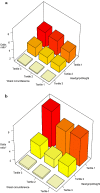The prediction of Metabolic Syndrome alterations is improved by combining waist circumference and handgrip strength measurements compared to either alone
- PMID: 33752666
- PMCID: PMC7986558
- DOI: 10.1186/s12933-021-01256-z
The prediction of Metabolic Syndrome alterations is improved by combining waist circumference and handgrip strength measurements compared to either alone
Abstract
Background: Adiposity is a major component of the metabolic syndrome (MetS), low muscle strength has also been identified as a risk factor for MetS and for cardiovascular disease. We describe the prevalence of MetS and evaluate the relationship between muscle strength, anthropometric measures of adiposity, and associations with the cluster of the components of MetS, in a middle-income country.
Methods: MetS was defined by the International Diabetes Federation criteria. To assess the association between anthropometric variables (waist circumference (WC), waist-to-hip ratio (W/H), body mass index (BMI)), strength (handgrip/kg bodyweight (HGS/BW)) and the cluster of MetS, we created a MetS score. For each alteration (high triglycerides, low HDLc, dysglycemia, or high blood pressure) one point was conferred. To evaluate the association an index of fat:muscle and MetS score, participants were divided into 9 groups based on combinations of sex-specific tertiles of WC and HGS/BW.
Results: The overall prevalence of MetS in the 5,026 participants (64% women; mean age 51.2 years) was 42%. Lower HGS/BW, and higher WC, BMI, and W/H were associated with a higher MetS score. Amongst the 9 HGS/BW:WC groups, participants in the lowest tertile of HGS/BW and the highest tertile of WC had a higher MetS score (OR = 4.69 in women and OR = 8.25 in men;p < 0.01) compared to those in the highest tertile of HGS/BW and in the lowest tertile of WC.
Conclusion: WC was the principal risk factor for a high MetS score and an inverse association between HGS/BW and MetS score was found. Combining these anthropometric measures improved the prediction of metabolic alterations over either alone.
Keywords: Abdominal obesity; Body mass index; Cardiovascular disease; Handgrip strength; Metabolic syndrome.
Conflict of interest statement
The authors have no competing interests to declare.
Figures


Similar articles
-
Comparison of Three Adiposity Indexes and Cutoff Values to Predict Metabolic Syndrome Among University Students.Metab Syndr Relat Disord. 2017 Sep;15(7):363-370. doi: 10.1089/met.2017.0016. Epub 2017 Jun 1. Metab Syndr Relat Disord. 2017. PMID: 28570830
-
Association between handgrip strength and metabolic syndrome in relation to gender and adiposity among middle aged and older Saudi populations.Aging Male. 2024 Dec;27(1):2325146. doi: 10.1080/13685538.2024.2325146. Epub 2024 Mar 11. Aging Male. 2024. PMID: 38468373
-
Anthropometric Cutoffs for Increased Cardiometabolic Risk Among Lebanese Adults: A Cross-Sectional Study.Metab Syndr Relat Disord. 2019 Dec;17(10):486-493. doi: 10.1089/met.2019.0033. Epub 2019 Sep 30. Metab Syndr Relat Disord. 2019. PMID: 31566527
-
Various Obesity Indices and Arterial Function Evaluated with CAVI - Is Waist Circumference Adequate to Define Metabolic Syndrome?Vasc Health Risk Manag. 2022 Sep 12;18:721-733. doi: 10.2147/VHRM.S378288. eCollection 2022. Vasc Health Risk Manag. 2022. PMID: 36120718 Free PMC article. Review.
-
Unraveling the role of muscle mass and strength in predicting type 2 diabetes risk: a systematic review.Acta Diabetol. 2025 Feb;62(2):157-176. doi: 10.1007/s00592-024-02440-9. Epub 2025 Jan 6. Acta Diabetol. 2025. PMID: 39760787
Cited by
-
Grip strength, metabolic syndrome, and type 2 diabetes mellitus: a prospective study.J Diabetes Metab Disord. 2025 May 10;24(1):118. doi: 10.1007/s40200-025-01614-8. eCollection 2025 Jun. J Diabetes Metab Disord. 2025. PMID: 40352117 Free PMC article.
-
Associations between skeletal muscle strength and chronic kidney disease in patients with MASLD.Commun Med (Lond). 2025 Apr 16;5(1):118. doi: 10.1038/s43856-025-00821-x. Commun Med (Lond). 2025. PMID: 40240577 Free PMC article.
-
Biomarkers and Data Visualization of Insulin Resistance and Metabolic Syndrome: An Applicable Approach.Life (Basel). 2024 Sep 21;14(9):1197. doi: 10.3390/life14091197. Life (Basel). 2024. PMID: 39337979 Free PMC article.
-
Combining Fat-to-Muscle Ratio and Alanine Aminotransferase/Aspartate Aminotransferase Ratio in the Prediction of Cardiometabolic Risk: A Cross-Sectional Study.Diabetes Metab Syndr Obes. 2023 Mar 15;16:795-806. doi: 10.2147/DMSO.S401024. eCollection 2023. Diabetes Metab Syndr Obes. 2023. PMID: 36945296 Free PMC article.
-
A Longitudinal Assessment of Metabolic Syndrome.J Clin Med. 2025 Jan 24;14(3):747. doi: 10.3390/jcm14030747. J Clin Med. 2025. PMID: 39941416 Free PMC article.
References
-
- Vu JD, Vu JB, Pio JR, Malik S, Franklin SS, Chen RS, et al. Impact of C-reactive protein on the likelihood of peripheral arterial disease in United States adults with the metabolic syndrome, diabetes mellitus, and preexisting cardiovascular disease. Am J Cardiol. 2005;96(5):655–658. doi: 10.1016/j.amjcard.2005.04.038. - DOI - PubMed
Publication types
MeSH terms
Grants and funding
LinkOut - more resources
Full Text Sources
Other Literature Sources
Medical

